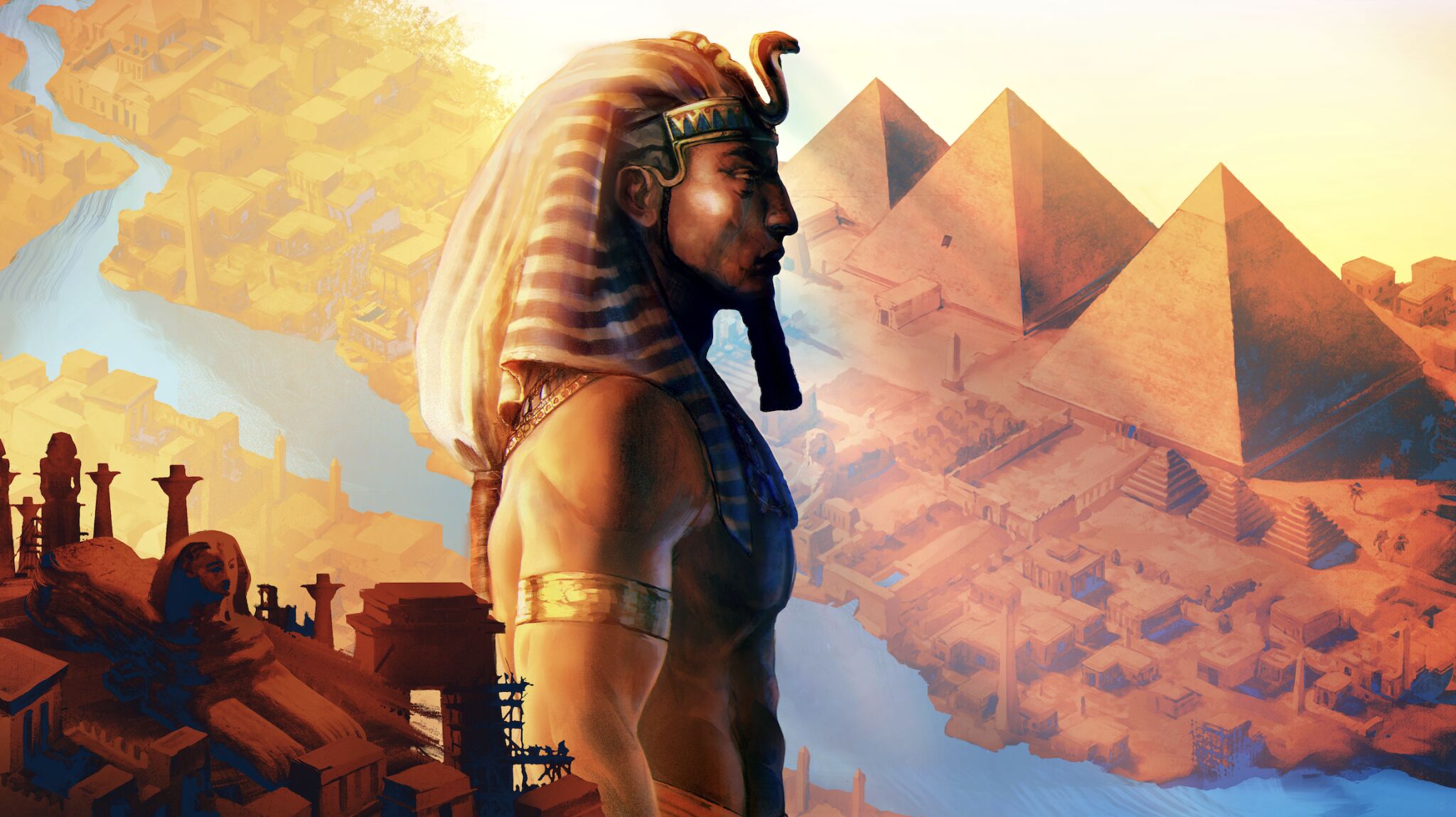It’s one of the most common questions in the world of biblical archaeology: Who was the pharaoh of the Exodus? This ruler is mentioned numerous times in the Bible. Yet the question of his actual name, and his precise place in Egyptian history, has plagued believers, philosophers, archaeologists, historians and other scholars for centuries—thousands of years, in fact.
There is no end to the theories about his identity. Prof. Emmanuel Anati believes it was Pepi i, a pharaoh on the scene as early as the 24th century b.c.e. Prof. Israel Finkelstein believes the Exodus account was modeled after the late-seventh century b.c.e. pharaoh Necho ii. Many popular films about the Exodus, including Cecil DeMille’s The Ten Commandments, DreamWorks’ The Prince of Egypt and Ridley Scott’s Exodus: Gods and Kings favor Ramesses ii (13th century b.c.e.).
A favorite among Bible maximalists is Amenhotep ii (15th century b.c.e.). Then there are the theories of the chronological revisionists: David Rohl believes it was Dedumose ii; Immanuel Velikovsky identified him as the otherwise obscure “Tom-Taoui-Toth.”
David Down opined Neferhotep i. Alfred Edersheim believed it was Thutmose ii. Herman Hoeh, originally following a form of Velikovskian chronology, initially believed it was Merenre Nemtyemsaf ii; later, following more conventional chronology, Amenhotep ii. Isaac Asimov believed it to be Merneptah. According to Sigmund Freud—yes, even the famous psychologist studied the question—Akhenaten was the key figure in the Exodus account.
Then there are the theories of the early historians. Josephus, the first-century c.e. Jewish author, believed it was one of the pharaohs named Thutmose. Manetho, the third-century b.c.e. Egyptian historian, identified him as one of the Amenhoteps. The first-century c.e. Roman historian Tacitus identified him as Bakenranef.
Overwhelmed yet? Amid the endless speculation, one can appreciate the title of John Gee’s 1997 journal article, “Who Was Not the Pharaoh of the Exodus?”
The Bible does name several later pharaohs (in the books of Kings, Chronicles and Jeremiah). But why doesn’t the Torah, the first five books of the Hebrew Bible, name a single one? There is, in fact, a rational explanation (see Sidebar 1, “Why the Ambiguity of the Exodus Pharaoh?”, at the bottom of this article).
Does answering this question require a vast revision of historical chronologies? Conversely, do we have to ignore or dismiss various biblical verses in order to reconcile secular history with the biblical?
Let’s dive into one of the most common and complex questions in biblical archaeology.
Identifying the Egyptian Period
Egypt is one of the oldest and best-documented civilizations in human history. From troves of archaeological evidence and numerous historical texts, we can divide its history into periods. A majority of scholars generally agree that the Bible’s Exodus account fits within Egypt’s New Kingdom Period, which spanned the second half of the second millennium b.c.e. (circa 1570–1070 b.c.e.), immediately prior to the period of Israel’s monarchy. Chronologically, this time frame encompasses the entire period of the Exodus, Israel’s sojourn in the wilderness, and the time of the judges.
This New Kingdom period not only fits tidily with events relating to the biblical Exodus, it also fits with the literary composition of the Torah itself. The Mosaic books are filled with language, references and nuances, from the use of various pharaonic phrases to personal names, that are uniquely associated with Egypt’s New Kingdom. (Moses’s address recorded in the book of Deuteronomy, for example, is almost identical in its layout to dozens of suzerainty treaties common during the New Kingdom period; to learn more about these parallels, read our article “Searching for Egypt in Israel.”)
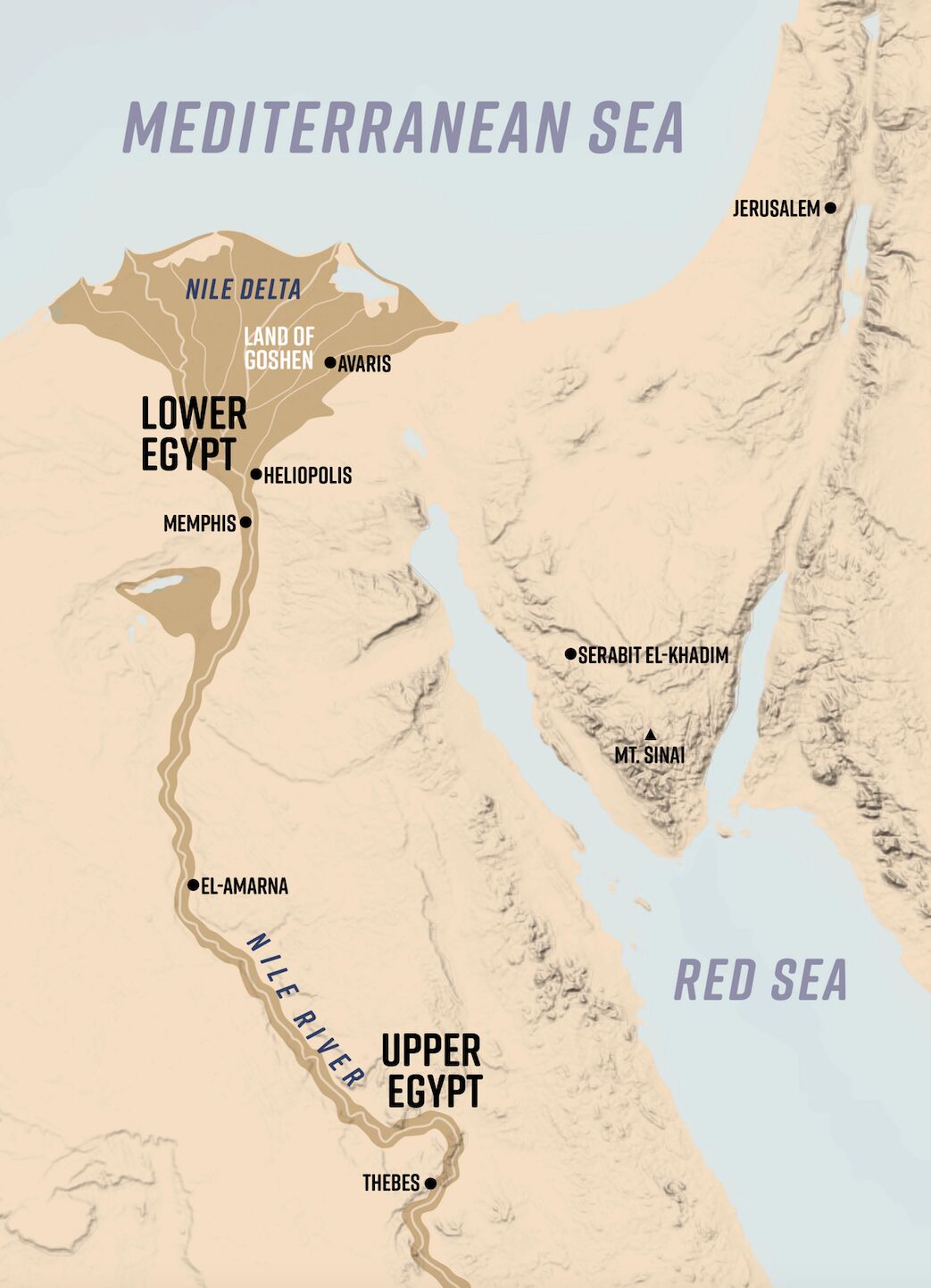
The New Kingdom followed a unique period in Egyptian history called the Second Intermediate Period (circa 1670–1570 b.c.e.). At this time, Egypt was split in two (see map, right). Southern Egypt (known as “Upper Egypt” due to its higher elevation) was ruled by native Egyptian pharaohs. Meanwhile, northern Egypt (or “Lower Egypt”), which encompassed the lush Nile Delta (biblical Goshen), was ruled by Semitic “shepherd” kings who had emigrated from Canaan. Egyptian history identifies these Semitic shepherds as the “Hyksos.”
The rule of the Hyksos in Egypt matches remarkably well with the biblical description of the first part of the Israelite sojourn in Egypt. Even now, 3,500 years later, the connection between the Hyksos and Israel is “frozen in the Egyptian memory to the point that to this day, the average person in Egypt thinks the Hyksos were Jews and associates them with destruction and chaos” (Jerusalem Post, July 19, 2020, citing Egyptologist Orly Goldwasser). For a full analysis of the subject of the Hyksos, see our article “The Hyksos: Evidence of Jacob’s Family in Ancient Egypt?”

The era of Hyksos dominance ended in the mid-16th century b.c.e. (this also marked the end of the Second Intermediate Period). At this time, the Hyksos were conquered by a dynasty of native, uber-nationalistic pharaohs ruling from Upper Egypt. These pharaohs subjugated the Hyksos and united the two regions under one government. Egypt’s unification, which began with Pharaoh Ahmose i, thrust the kingdom into a “golden age” and marked the beginning of this New Kingdom period.
Egypt’s overthrow of the Hyksos also has uncanny similarities with the events recorded in Exodus 1. “And the children of Israel were fruitful, and increased abundantly, and multiplied, and waxed exceeding mighty; and the land was filled with them. Now there arose a new king over Egypt, who knew not Joseph. And he said unto his people: ‘Behold, the people of the children of Israel are too many and too mighty for us; come, let us deal wisely with them …’” (verses 7-10).
But Which Egyptian Dynasty?
Israel’s ensuing oppression and the Exodus fit well, then, within the general New Kingdom period. But we can get even more specific. Historians divide the New Kingdom into three different dynasties. The first is known as the 18th Dynasty, or the Thutmosid Dynasty (dynasties were named after the ruling family); this dynasty ruled Egypt up until around 1300 b.c.e. The second and third (the 19th and 20th dynasties) are referred to as the Ramesside Dynasties, extending from about 1300 to 1070 b.c.e.

One of the most popular theories claims that the pharaoh during the Exodus was Ramesses ii, a 13th-century pharaoh. Despite this popular identification, numerous biblical passages—including the singular verse highlighted by Ramesside proponents (Exodus 1:11)—reveal that neither Ramesses ii nor any of the Ramesside Dynasty pharaohs could have been the Exodus pharaoh (see Sidebar 2, “Hollywood’s Favorite Pharaoh,” at the bottom of this article; for further detail, see our article “The ‘Raamses’ of Exodus 1:11: Timestamp of Authorship? Or Anachronism?”).
When it comes to biblical chronology, the biblical text clearly points to the Exodus occurring during the 15th century b.c.e.—within the Thutmosid Dynasty.
1 Kings 6:1, a verse that connects the Exodus to the construction of Solomon’s temple, is a key piece of evidence. “And it came to pass in the four hundred and eightieth year after the children of Israel were come out of the land of Egypt, in the fourth year of Solomon’s reign … he began to build the house of the Lord.” Solomon’s reign is widely recognized to date to the middle part of the 10th century b.c.e. More specifically, many scholars identify the construction of Solomon’s temple as beginning in 967 b.c.e. (see our article here for more detail.)
Thanks to 1 Kings 6:1, calculating the date of the Exodus is simple arithmetic: 480 years prior to the early-to-mid-10th century b.c.e. puts the Exodus somewhere in the mid-15th century b.c.e. and places Israel’s entrance into Canaan (40 years later) somewhere at the end of that century. More specifically, if we are to use the widely accepted date of 967 b.c.e., this would put the Exodus in 1446 b.c.e. and Israel’s entrance into Canaan 40 years later, in 1406 b.c.e.
But 1 Kings 6:1 does not just stand on its own—other passages can be used to cross-check and corroborate the dating of the Exodus to the 15th century b.c.e. For example, Judges 11:26 states that at the time of the judge Jephthah—circa 1100 b.c.e.—the Israelites had dwelt in the land of Canaan for about “three hundred years” (thus putting their arrival at around 1400 b.c.e.). There is also the Levitical genealogical information documented in 1 Chronicles 6, listing 19 generations from the Exodus to the construction of Solomon’s temple: This is an impossibly large number to fit inside a 13th-century Ramesside Exodus, yet it fits neatly within the time frame of a 15th-century Exodus during the Thutmosid Dynasty. (To study this particular topic further, see our articles on the subject here, here and here.)
With the general biblical time frame of the Exodus established, thus confining our search to Egypt’s Thutmosid Dynasty (circa 1570–1300 b.c.e.), we can look more closely for evidence of events associated with the Exodus and, additionally, evidence that might reveal the identity of Egypt’s pharaoh at the time.
But to do this, we must avoid what I believe to be one of the pitfalls in this debate: We should not lock ourselves from the outset into an excessively rigid, year-by-year chronological reconstruction. Instead, we should maintain a sensible amount of flexibility when it comes to specific dates, stepping back and viewing the broader progression of events more fully before zooming in with hyper-specificity. While creating intricate and specific chronologies is fascinating, it’s also fickle. This history occurred nearly 3,500 years ago; it can be virtually impossible to settle on absolute dates for many events. There is significant debate over exact dates during this New Kingdom period (the arguments revolve around years and decades, however, not the centuries of extreme chronological revisionists). Should we adhere to low chronology? Middle chronology? High? Variations thereof? Furthermore, ongoing discoveries constantly require scholars to tweak and refine timelines.
For the purposes of this particular article, we’ll avoid fixating on specific dates. Going forward, we’ll refer to more general periods of time rather than specific years. (For more detailed specifics about the dating of the following pharaohs, see Sidebar 3, “Dating Specifics: Pharaohs of the 18th Dynasty,” at the bottom of this article.)
We have our period: New Kingdom. We have our dynasty: Thutmosid. Now we can look more closely at specific pharaohs.
Akhenaten

We’ll begin with Pharaoh Akhenaten, an early-mid 14th-century b.c.e. ruler (preferring a high chronology dating—more on this at the end of this article), and extrapolate backward.
Akhenaten’s reign marked a time of major upheaval in Canaan, which at this time was loosely controlled by Egypt. The disturbance was primarily due to the violent conquests within Canaan of the Habiru people, as documented in the Amarna Letters. The invasion of Canaan by the Habiru fits remarkably well with the biblical account of Israel’s conquest of Canaan, which began around 1400 b.c.e. and continued for several decades on into the 14th century. (This Habiru “conquest” started during the reign of Akhenaten’s father, Amenhotep iii.) To learn more about the Amarna Letters and the astonishing parallels between the Habiru conquest of Canaan and the biblical Hebrew conquest of Canaan, read our article “The Amarna Letters: Proof of Israel’s Invasion of Canaan?”

But Pharaoh Akhenaten’s reign is noteworthy for another reason: During this period, Egypt’s polytheistic religious system was completely upended and replaced by an unprecedented turn toward monotheism (specifically, the worship of the sun-god Aten; in fact, Akhenaten renamed himself after the god—his original regnal name was Amenhotep iv).
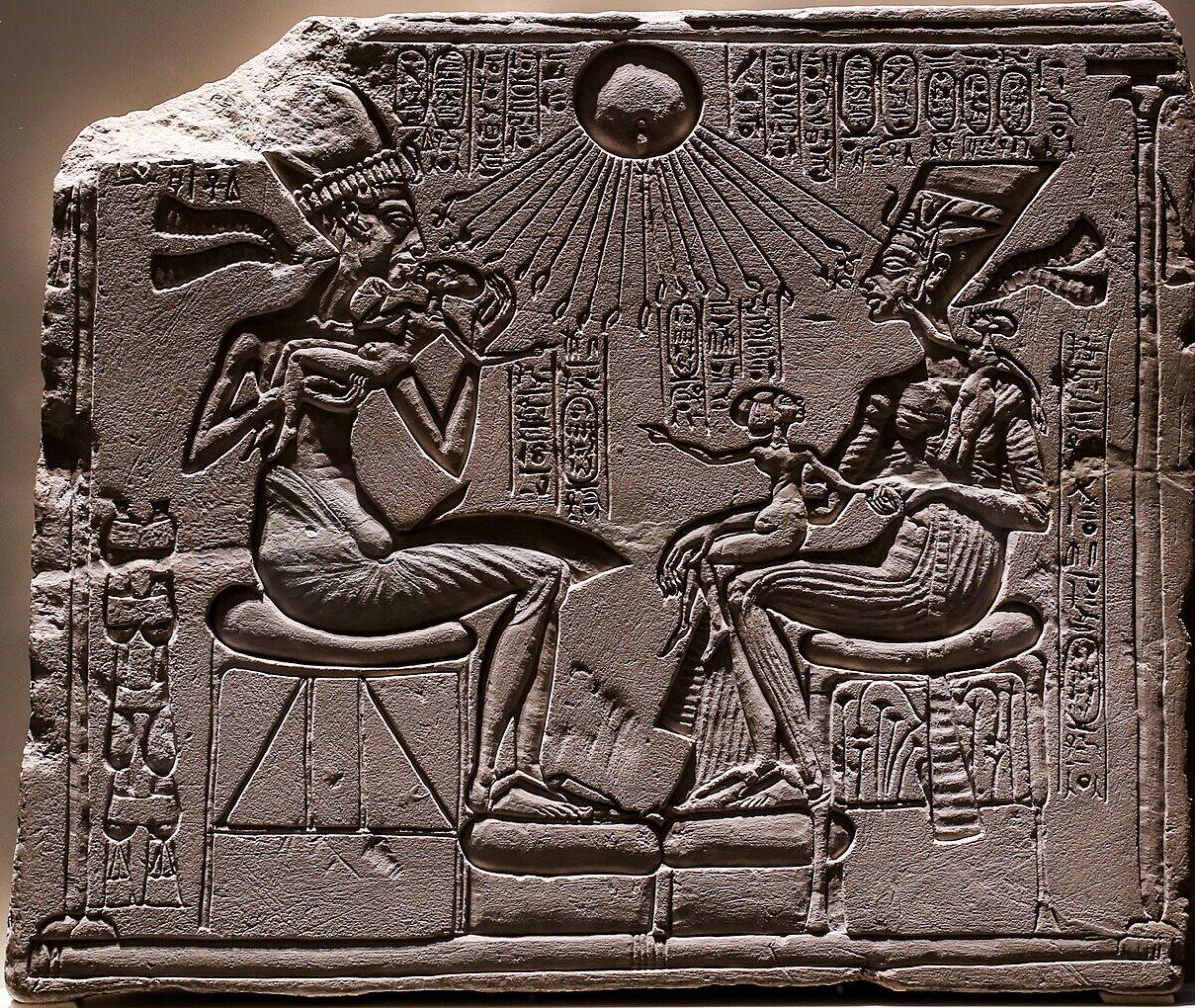
What caused this extraordinary religious transformation? Some scholars believe it was simply an aberration in Egyptian history. Various researchers have labeled Akhenaten a “revolutionary,” “heretic” and “fanatic.” Some claim he was “possibly insane.” Some, noting the Amarna Letters—which document his failure to send military aid to Canaan to defend against the Habiru—call him a “pacifist.” But name-calling doesn’t explain the major religious upheaval under Akhenaten. Does archaeology provide insight?
A pylon inscription at the Karnak temple complex near Thebes records a jaw-dropping speech by Akhenaten. It reads, in part: “The temples of the gods are fallen to ruin, their bodies do not endure. … I have watched as they have ceased their appearances, one after the other. All of them have stopped, except the god who gave birth to himself. And no one knows the mystery of how he performs his tasks. This god goes where he pleases and no one else knows his going” (emphasis added throughout).
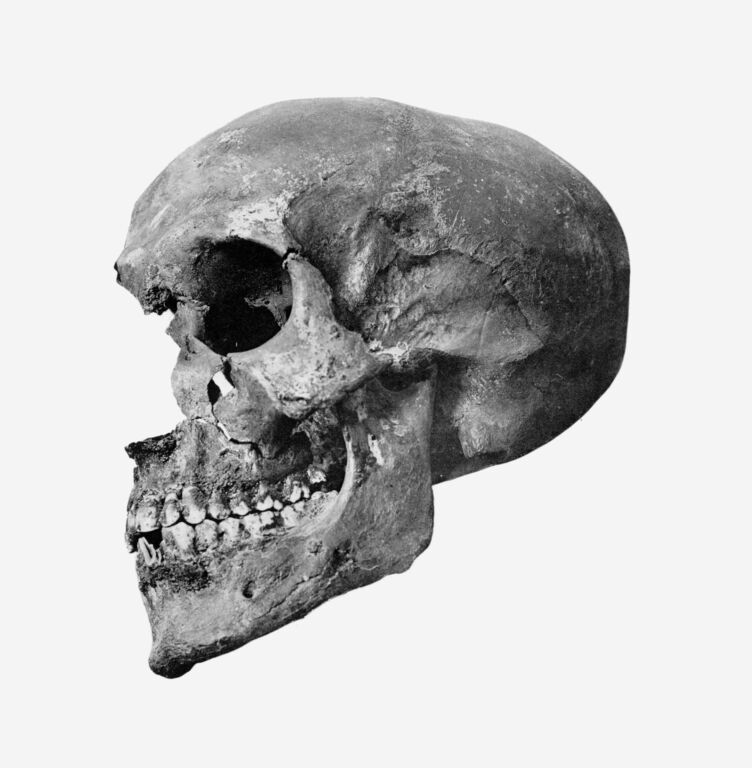
Pharaoh Akhenaten’s speech reflects the total loss of faith in Egypt’s numerous gods. Is it mere coincidence that within the same dynasty and chronologically only decades after the biblical Exodus—during which Egypt’s various gods were proved powerless—we witness the total overhaul of Egypt’s religious system? Akhenaten’s moving speech is unthinkable in ancient Egypt; it’s a massive historical anomaly. Could this pharaoh’s reforms have been a consequence of what the biblical record identifies as plagues aimed “against all the gods of Egypt”? (Exodus 12:12).
Amenhotep iii
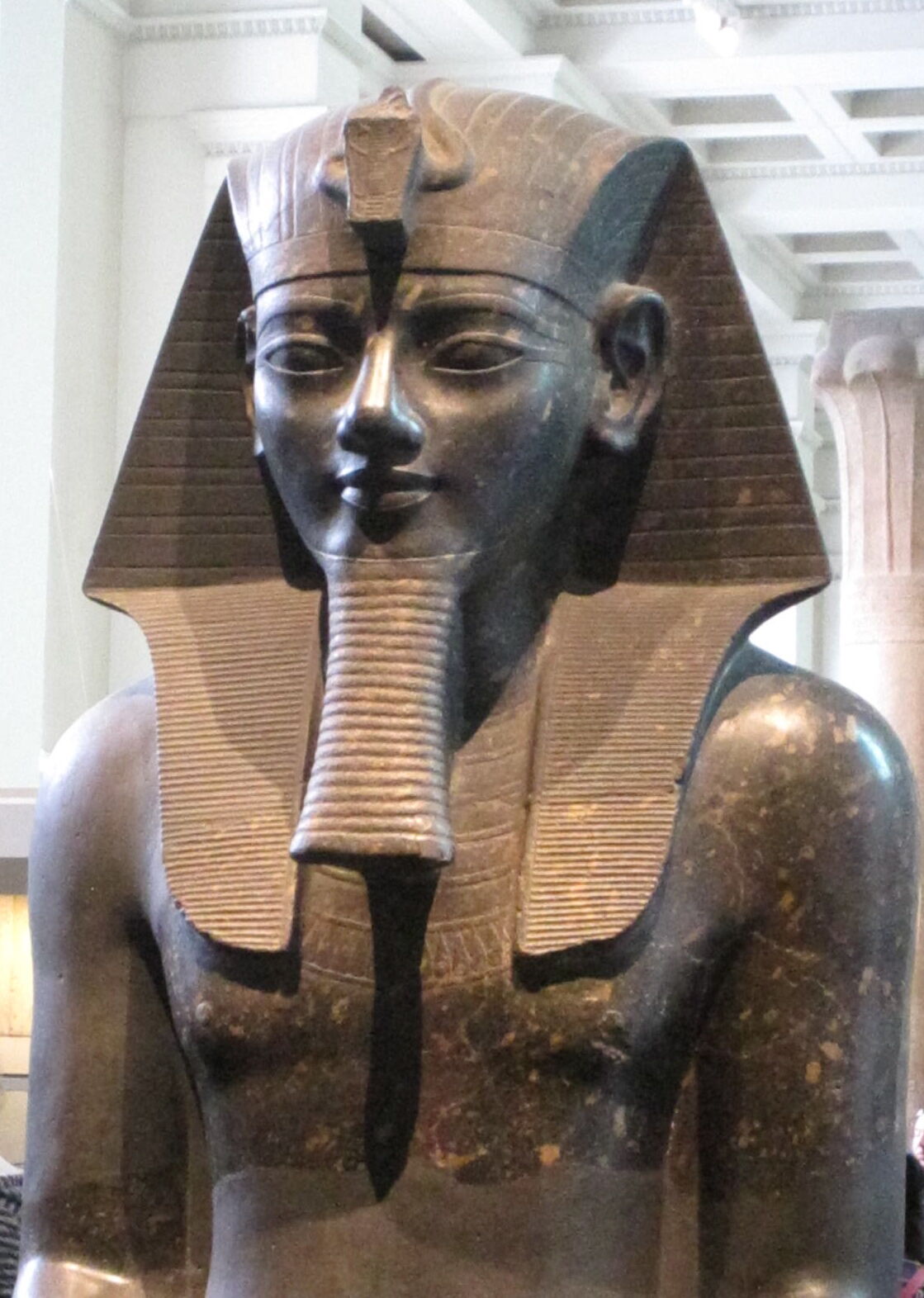
Prior to Akhenaten, Egypt was led by his father, Pharaoh Amenhotep iii. Amenhotep iii ruled for around 40 years, from the late 15th century into the early 14th. Some Egyptologists actually believe he laid the groundwork for the religious transformation that occurred under Akhenaten.
Like his son, and unlike most pharaohs, Amenhotep iii is characterized as a “pacifist.” Despite his long reign, he is known to have participated in only one military campaign (this was south of Egypt, not east toward Canaan, where several earlier pharaohs had campaigned). Amenhotep iii was known for his construction of statues—lots of them. But here too is something unusual: Some six hundred statues commissioned by Amenhotep iii are devoted to Sekhmet, the goddess of healing.
Why the emphasis on healing? And why no wars?

Another interesting find emerges from Amenhotep iii’s reign: A pylon inscription from his royal necropolis at Soleb refers to a nomadic group of people called the “Shasu (Nomads) of yhwh.” No further detail is recorded about this wandering body of people, other than the fact that they were apparently located somewhere east of Egypt (based on the positioning of such pillar inscriptions). Amenhotep’s inscription is the earliest-known mention of the famous name of Israel’s God, yhwh (read more about this discovery in our article here).
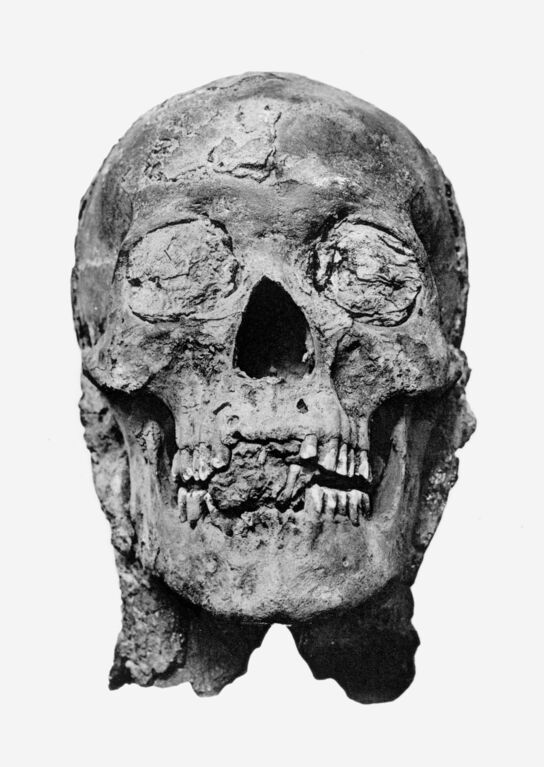
Is it coincidence that the end of Amenhotep iii’s reign and the body of Akhenaten’s aligns with Israel’s conquest of Canaan? Is it coincidence that the body of Amenhotep iii’s reign fits with Israel’s nomadic sojourn? And isn’t it interesting that Egypt under Amenhotep iii experienced an uncharacteristic pacifism, with a peculiar devotion to Sekhmet, the goddess of healing—followed by the eventual complete collapse in Egypt’s religious system?
Thutmose iv
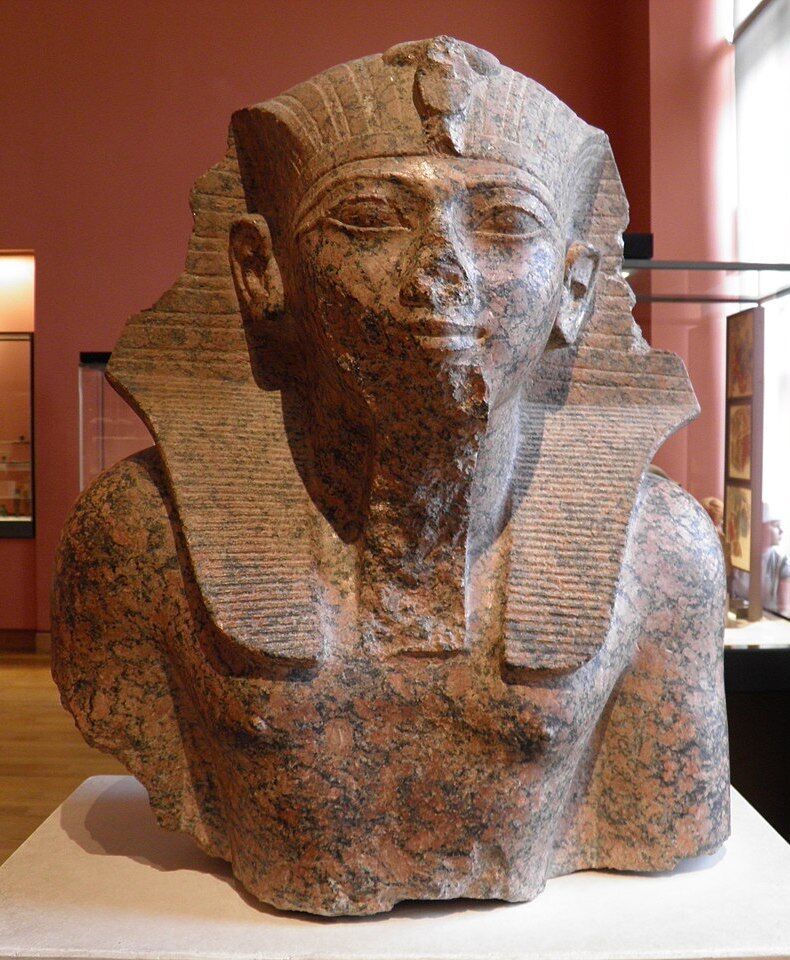
Amenhotep iii’s father and predecessor was Pharaoh Thutmose iv. This pharaoh reigned for just nine years in the second half of the 15th century. Short though it was, Thutmose’s rule was a surprise. We know this thanks to the Dream Stele.
The Dream Stele is a nearly 4-meter-tall granite inscription that was installed between the paws of the Great Sphinx of Giza. This massive stele was erected during the first year of Thutmose iv’s reign. The text, commissioned by Thutmose iv, essentially constitutes a unique and unusual divine justification for his reign.
Why was Thutmose iv compelled to publicly declare that he was divinely installed? Because he was not the firstborn, presumptive heir to Egypt’s throne. “It is unfortunate that the events surrounding the accession of Thutmosis iv are so obscure,” writes Egyptologist Peter Der Manuelian, “especially since his Dream Stele between the paws of the Great Sphinx suggests that he was not the originally intended heir to the throne“ (Studies in the Reign of Amenophis ii).
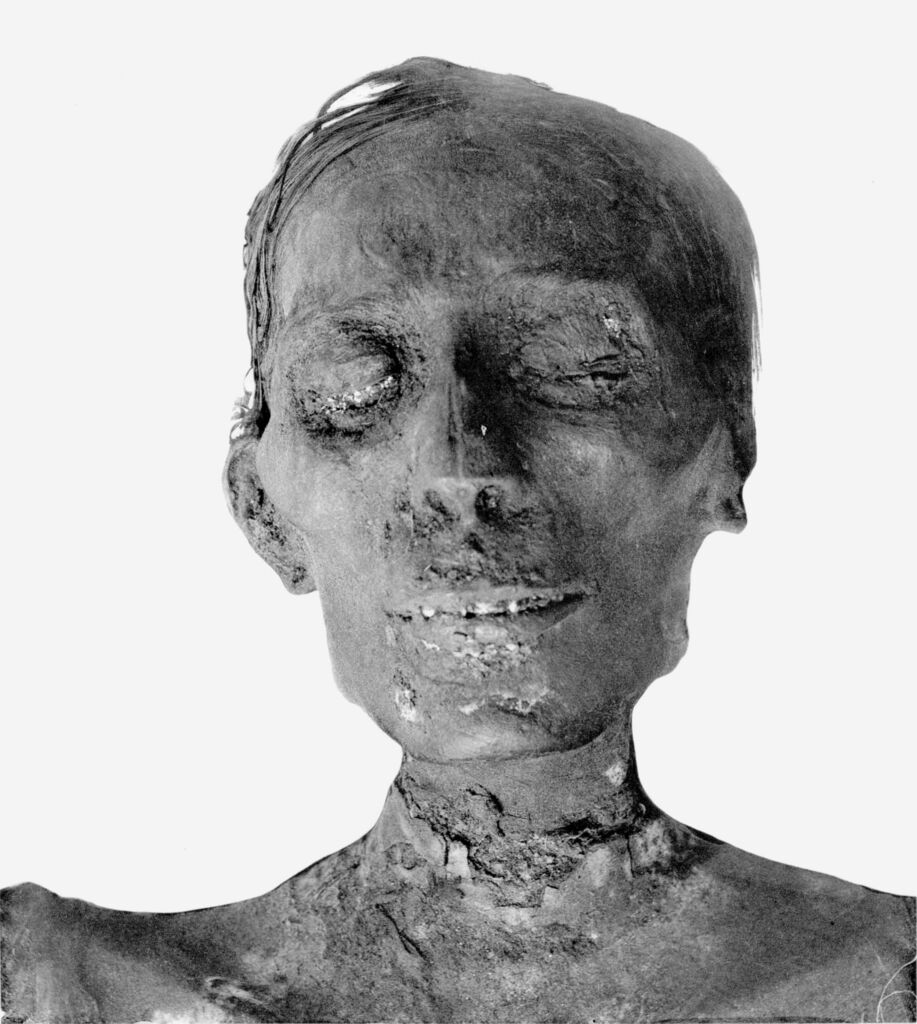
What happened to the firstborn whose place Thutmose assumed? Some scholars wonder if Thutmose iv murdered his way to the throne. But there’s no evidence to support this view, and there are various difficulties with this interpretation. Yet the fact that Thutmose iv was not the firstborn son and assumed Egypt’s throne unexpectedly fits squarely with the biblical account of the 10th plague: the death of the firstborn, which included Egypt’s crown prince. “And it came to pass at midnight, that the Lord smote all the firstborn in the land of Egypt, from the first-born of Pharaoh that sat on his throne unto the first-born of the captive that was in the dungeon …” (Exodus 12:29). Thutmose iv, then, would be a good fit with the surviving, non-firstborn successor to the Exodus pharaoh.
But there’s more: The fact that the pharaoh of the Exodus also survived the 10th plague logically implies that he too was not a firstborn. And fascinatingly, Egyptian records reveal that the father of Thutmose iv—Egypt’s ruler in the crucial middle part of the 15th century b.c.e.—was likewise not the firstborn heir to the throne.
In logical progression, then, this would place Thutmose iv’s father as the pharaoh of the Exodus!
Thus far, we have examined the Thutmosid Dynasty pharaohs who came after the Exodus, going backwards in time to the Exodus. But before we explore the Exodus pharaoh himself, let’s consider the pharaohs before him—that is, some of the earlier, pre-Exodus pharaohs of the Thutmosid Dynasty, moving forwards in time to the Exodus—to see if we also have a match for the biblical account.
Thutmose i
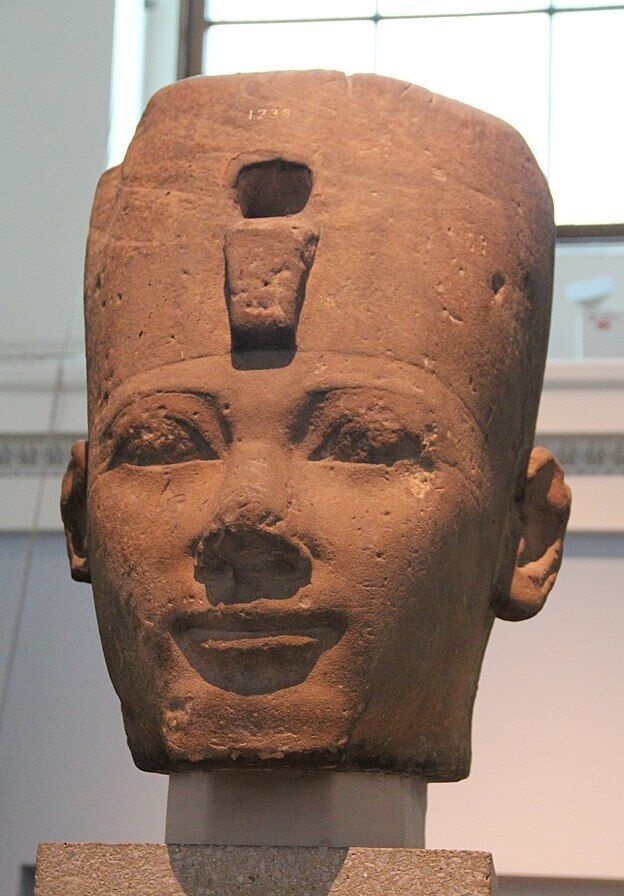
With the Israelites entering Canaan in the late 15th century b.c.e., during the reign of Amenhotep iii, we can use the life of Moses to develop a timeline. The biblical account shows that Moses died at the age of 120, with his life divided into three 40-year periods: First, he was a prince in Egypt; second, he dwelt in the wilderness of Midian; and third, at the age of 80, he was called to deliver Israel from Egypt and took them, over a period of 40 years, to Canaan (Exodus 7:7; Deuteronomy 29:4; etc).
If Israel entered Canaan at the end of the 15th century, Moses must have been born in the last half of the 16th century b.c.e. Depending on where exactly we anchor his death during the reign of Amenhotep iii, this would place the birth of Moses somewhere within the reign of Thutmose i.
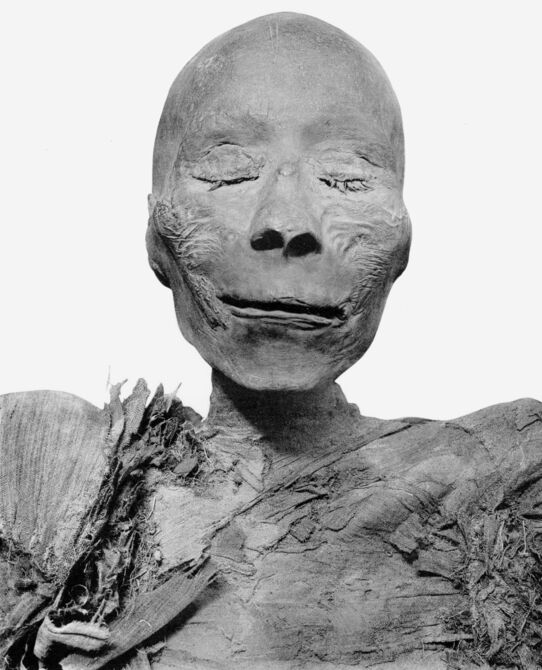
Pharaoh Thutmose i, the grandson or son-in-law (still debated) of the New Kingdom progenitor Ahmose i, was a powerful pharaoh known for massively expanding Egypt’s borders. Egyptian records show that Thutmose i commissioned major construction projects throughout Egypt, requiring a massive labor force. Thutmose i, therefore, would fit well as one of the pharaohs of Israel’s oppression.
The children of Thutmose i are especially intriguing. This pharaoh sired a fully royal daughter, Hatshepsut (born through his Great Royal Wife, Ahmose), and a half-royal son, Thutmose ii (born through his minor wife, Mutnofret). In order to secure his son’s rightful place on Egypt’s throne, Thutmose i had his 18-year-old son marry his 24-year-old half-sister.
Thutmose ii

Thutmose ii was a weak and apparently sickly pharaoh. His reign was short; his rule may have lasted as few as three years. Despite this, Thutmose ii was no less brutal: A rather remarkable discovery from within his reign highlights an Egyptian practice at this time, of killing the male children of enemies.
The Aswan Inscription, from the first year of Thutmose ii’s reign, records the following about a southern campaign against “the vile Kush”: “‘As I live, as Ra loves me, as my father lord of the gods praises me, I will not leave a male alive.’ … [T]his army of his majesty overthrew these foreigners, they took the life of every male according to all that his majesty commanded; excepting that one of those children of the prince of Kush was brought alive as a live prisoner with their household to his majesty ….”

Sound familiar? Exodus 1:22 records the pharaoh’s command to destroy male infants born to Hebrew mothers: “And Pharaoh charged all his people, saying: ‘Every son that is born ye shall cast into the river, and every daughter ye shall save alive.’” Evidently, it seems that such androcide must have been an established practice in late 16th century b.c.e. Egypt. Moses, of course, was miraculously spared from such a fate, having been placed in a basket on the Nile River and found by the “pharaoh’s daughter.”
Was this Hatshepsut, the royal daughter of Thutmose i, and the wife and half-sister of Thutmose ii?
Hatshepsut

Hatshepsut failed to produce a male heir for Thutmose ii, who instead conceived his successor, Thutmose iii, through a concubine named Iset. Thutmose iii was just 2 years old when his father died, however, so Hatshepsut initiated a 22-year coregency with Thutmose iii and became a powerful pharaoh in her own right. From the reign of Hatshepsut, we glean interesting tidbits that point to her identification as the famous “pharaoh’s daughter” mentioned in Exodus. Hatshepsut often referred to herself on monuments as the pharaoh’s royal “daughter” (despite her father Thutmose i having been long dead), apparently emphasizing her fully royal heredity.
Sir William Flinders Petrie (the “father of Egyptian archaeology”) noted that Pharaoh Hatshepsut’s “activity seems to have been entirely given to peaceful enterprises,” in “an age of tranquility to the realm” (A History of Egypt, Vol. ii). One remarkable inscription on the facade of her temple at Speos Artemidos reads, in part: “my spirits inclined toward foreign people … the people Roshau and Iuu did not hide themselves from me.” Another inscription describes a “heart full of love.” These extraordinary sentiments fit well with the biblical description of a “pharaoh’s daughter” who adopted a foreign child.
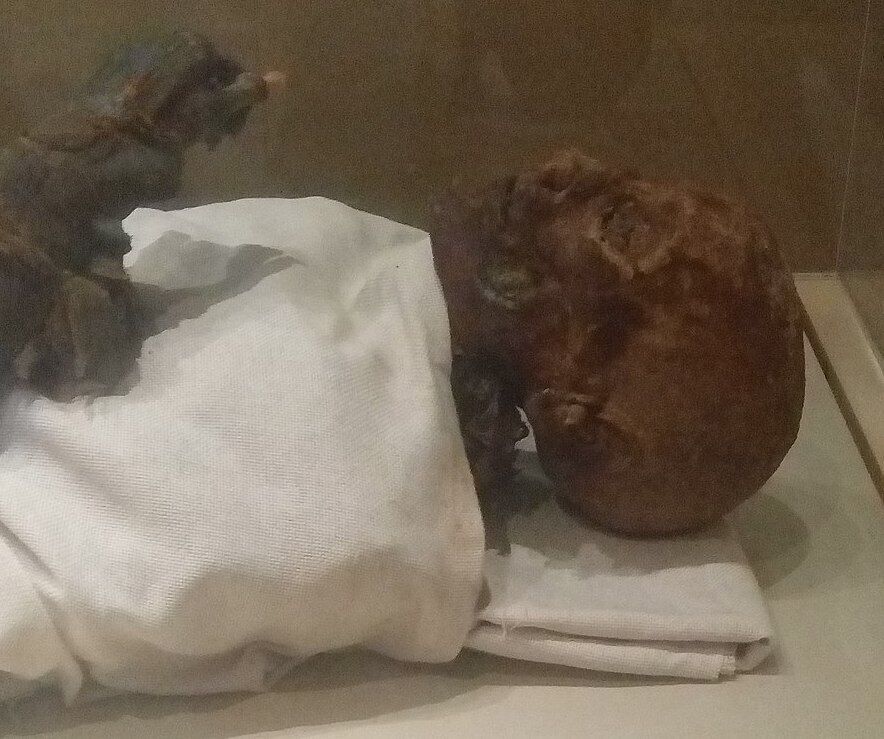
Unfortunately, her peaceful 22-year legacy was eventually expunged by a later pharaoh, who utterly destroyed and defaced Hatshepsut’s monuments, statues and inscriptions, plastering over them and re-inscribing them with alternative texts. This act of damnatio memoriae was systematic and near-total. Who was the culprit? Many scholars identify him as the father of Thutmose iv—our pharaoh of the Exodus.
Why the vitriolic excision of Hatshepsut’s legacy? Some scholars propose that it was simply because she was a female ruler. But that seems hardly sufficient. Is there more to the story? Did the Exodus pharaoh seek to eradicate the memory of Hatshepsut because he resented her affection “toward foreign people”? Could he have blamed Hatshepsut for nurturing Moses in Egypt’s royal court and causing the events that ultimately led to Israel’s dramatic Exodus and Egypt’s ruin?
Interestingly, there was a remarkable figure that came on the scene during the reign of Hatshepsut—a “peasant” and “commoner” who, for whatever untold reason, was catapulted to the highest levels of Egyptian administration and princedom during her reign—before he disappeared without a trace, sometime during the 1480s b.c.e. (again, following a high chronology framework). Could this individual and Moses have been one and the same? (Read our article “Is This Moses?” for a study into this subject.)
Thutmose iii

Counting his coregency with his stepmother Hatshepsut, Thutmose iii reigned 54 years, one of the longest in Egyptian history. As sole monarch, Thutmose iii set about forging himself into arguably Egypt’s greatest, most powerful pharaoh. Unquestionably, he was Egypt’s greatest conqueror. Through his manifold campaigns, this “Napoleon of Egypt” (as he is sometimes called) created the largest empire Egypt had ever seen.
It’s easy to imagine the pharaoh of the Exodus as Egypt’s most impressive ruler. But logically, it makes more sense that this acclaim would have belonged to the pharaoh who preceded him. Indeed, it was in association with the reign of the Exodus pharaoh’s father, just prior to Moses’s divine calling to save the Israelites, that the Israelites “sighed by reason of the bondage, and they cried, and their cry came up unto God” (Exodus 2:23).
Thutmose iii’s lengthy rule spanned much of the first half of the 15th century b.c.e. During this extended period of time, there is a good chronological fit with Moses being in Egypt’s royal court, then fleeing into the Midian wilderness where he lived for a significant length of time. “And it came to pass in the course of those many days [while Moses was in Midian] that the king of Egypt died …. And the Lord said unto Moses in Midian: ‘Go, return into Egypt; for all the men [the pharaoh, as well as certain other high officials] are dead that sought thy life’” (Exodus 2:23, 4:19). The phrase “many days” is not only a clear reference to Moses’s lengthy stay in Midian, it’s an obvious reference to the lengthy reign of Egypt’s pharaoh at that time. In short, it’s a good match with Pharaoh Thutmose iii, one of Egypt’s longest-serving monarchs.
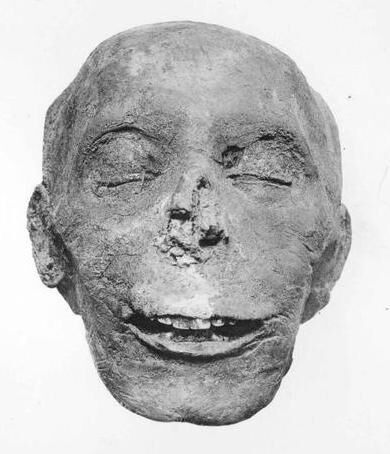
If Thutmose iii preceded the Exodus pharaoh, then his firstborn son and heir-apparent—the royal prince, Amenemhat—would presumably be the pharaoh of the Exodus. But in Egyptian records, Amenemhat is barely a historical footnote. Why? Because Thutmose iii’s firstborn son died before his father. When Pharaoh Thutmose iii died, Egypt’s throne was inherited by a non-firstborn son. His name?
Amenhotep ii.
Meet Amenhotep ii

Egyptian records show that Pharaoh Amenhotep ii assumed the throne when he was 18 and reigned for 26 years. His rule began vigorously as the young king followed in the footsteps of his powerful father. Several royal inscriptions show that Amenhotep ii initiated three massive military campaigns; these conquests occurred during the first half of his reign, in years 3, 7 and 9. During his third campaign, Amenhotep ii apparently imported more than 101,000 captives from the Levant into Egypt (the highest number of slaves brought into Egypt by any pharaoh).
Such a slave force, naturally, requires slave masters. And there is none more famous than vizier Rekhmire, one of Amenhotep ii’s foremost officials. The walls of Rekhmire’s mid-15th-century tomb are adorned with paintings of Semitic slaves making bricks from mud, water and chaff (following precisely the recipe detailed in Exodus 5). An inscription in Rekhmire’s tomb reads: “Rejoice, O prince, all your affairs are flourishing. The treasure stores are overflowing ….”
Compare this with Exodus 1:11, which says explicitly that Israelite slaves constructed “treasure cities” (King James Version). Interestingly, the third-century b.c.e. Septuagint version of Exodus 1:11 identifies Heliopolis as one of these key Egyptian treasure cities at this time. This same city is repeatedly found to be associated with Amenhotep ii on ancient inscriptions; several inscriptions refer to the pharaoh as “Amenhotep, the god who rules in Heliopolis.”
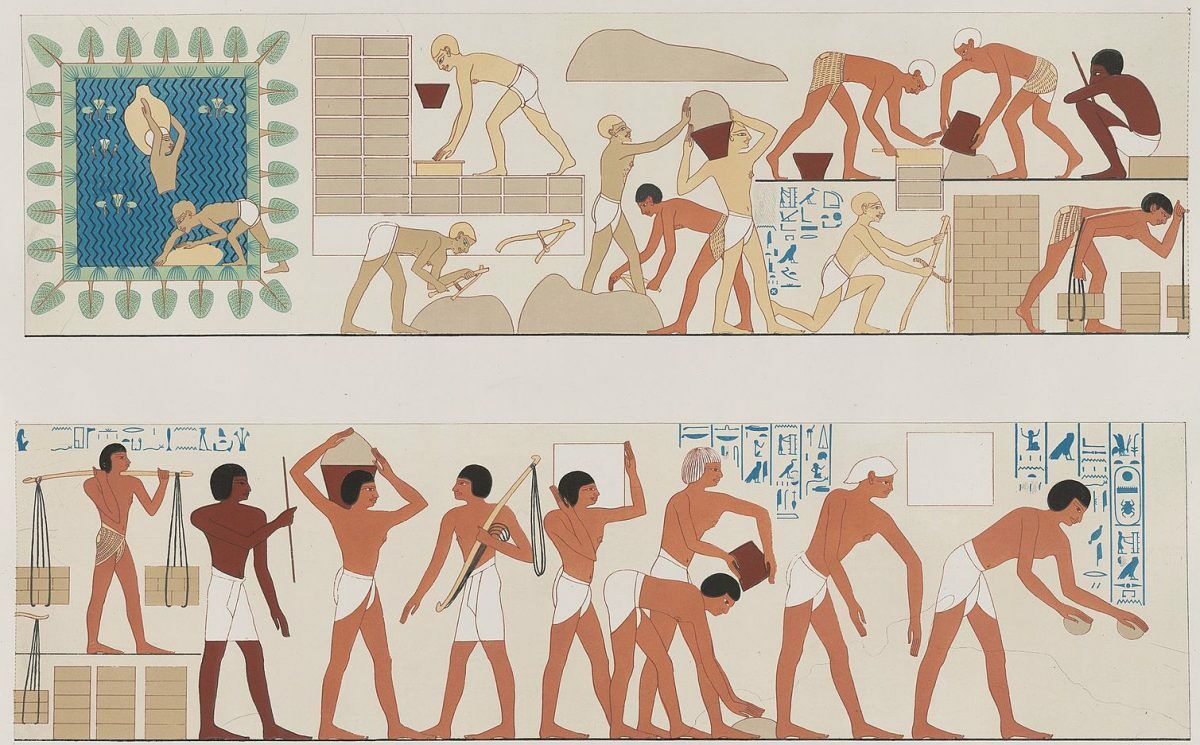
Amenhotep ii’s conquests and building projects were not as impressive as his father’s. But this pharaoh was infamous for something else: his cruelty.
This is highlighted at length in Manuelian’s authoritative work on Amenhotep ii, Studies in the Reign of Amenophis ii (“Amenophis” is the Classical Greek form of the name Amenhotep). Manuelian writes that the pharaoh’s Amada and Elephantine stelae “seem to emphasize first and foremost the glorification of the king through examples of excessive cruelty. Though the literary and artistic motif of a pharaoh smiting his enemies enjoys a history as long as that of the unification of the Two Lands itself [the start of the New Kingdom, with the reign of Ahmose i], Amenophis may have taken royal ruthlessness to new extremes …. [His inscriptions reveal] a penchant for what seems almost a casual narration of the king’s gruesome treatment of his enemies.”
Inscriptions documenting Amenhotep ii’s Year 3 campaign, for example, record how he transported enemy leaders tied upside down to the bow of his royal ship, before nailing them—minus their hands—to the walls of Thebes and Napata.
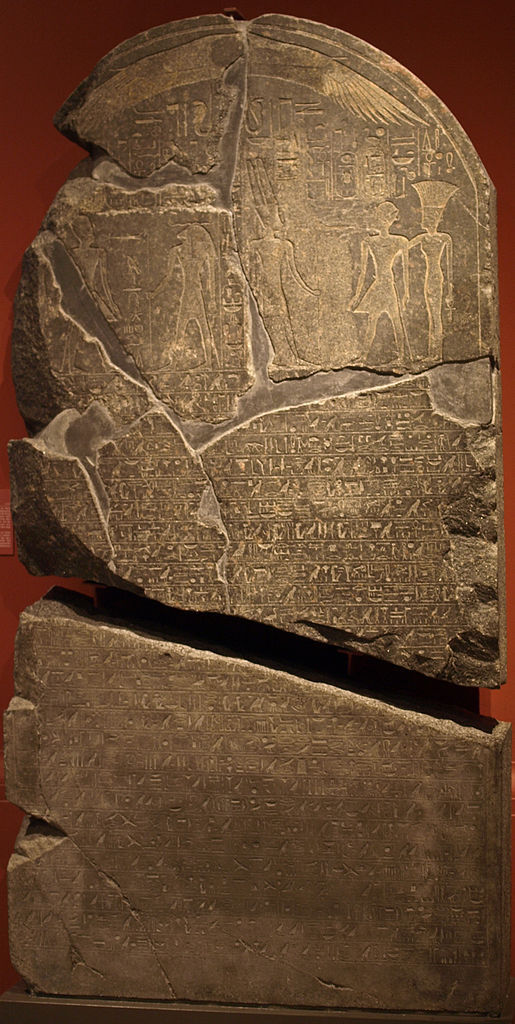
“Both the Karnak and Memphis narratives give a description of the king’s might and brutality,” explains Manuelian. He highlights one “rather macabre affair” in which, on his Year 9 campaign, Amenhotep ii ordered trenches to be dug, which he then filled with prisoners whom he set ablaze in “a fiery holocaust.” “[S]uch brutal treatment of his enemies [in this Year 9 campaign] should not surprise us in Amenhotep ii’s case” based on the precedent of his earlier campaigns, Manuelian writes. These textual accounts also go together with various artistic depictions in Egypt of the pharaoh on campaign—scenes that “depict the king in his chariot with bound captives … tied to the chassis.”
Compare this record with the biblical text, which repeatedly describes the Exodus pharaoh as having a “hardened heart.” Is there a better fit than Amenhotep ii—a pharaoh of “excessive cruelty,” who took “royal ruthlessness to new extremes”?
But perhaps the most notable observation about the archaeological record of Amenhotep ii pertains to the last half of his 26-year reign. In short, it’s virtually nonexistent!
What Happened?
Again, Amenhotep ii is known for engaging in campaigns in years 3, 7 and 9. But after his third campaign, we have almost no record of his reign. “Of the remainder of his reign,” wrote Sir William Petrie, “we know nothing.” In the words of Manuelian, this “silence … plays too large a role in assessing Amenophis ii’s policies, for not a single text has survived which describes a major act or decree of any historical significance.”
The same is true of his monuments, none of which, as Petrie wrote, can be “dated above the fifth year.” Furthermore, of the monuments we do have from Amenhotep ii’s reign, some of them are clearly only partially complete. “Nothing strikes us as more extraordinary than the condition of injury and confusion in which the most important buildings of Egypt seem to have remained,” Petrie wrote. “The most imposing works stood amidst half-ruined and unfinished halls for a whole reign; other parts were walled off to hide offensive memorials; other structures were either incomplete or half-ruined” (ibid). (Add to this the destruction of of Hatshepsut’s monuments at this time.)
What happened in the latter part of Amenhotep ii’s reign? And why was his reign so short, at least compared to that of his father? As Manuelian notes, Amenhotep ii was young and healthy; he is arguably known as Egypt’s most athletic pharaoh, with remarkable aptitude for archery and chariotry. Yet Amenhotep ii died in his early 40s—an age corroborated by analysis of his mummy (CG 61069, from tomb KV35; see Sidebar 4 at the bottom of this article, “How Did the Exodus Pharaoh Die?”).
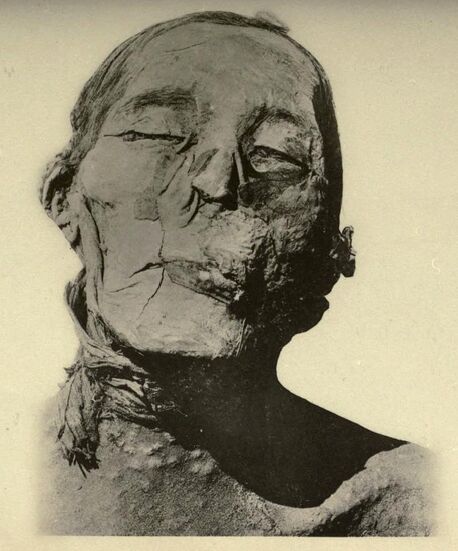
In 1907, when Amenhotep ii’s mummified body was examined, scientists noticed the presence of unusual tubercles all over the body. Grafton Elliot Smith, who studied the corpse, wondered whether the tubercles developed during the embalming process or were the product of disease. As he wrote in “A Note on the Mummies in the Tomb of Amenhotep ii at Bibân el Molouk” (1907): “The skin over the whole body [of Amenhotep ii] is thickly studded with small projections or tubercles from 0 m. 002 mill. to 0 m. 008 mill. in diameter. At present I am unable to determine whether they are the results of some disease or merely the effects of the embalmer’s salt-bath, but they are certainly unusual.” Amenhotep ii’s exact cause of death is unknown, but evidence of disease would certainly fit with the biblical account of the plagues.
There is one particular inscription from Year 23 of Amenhotep ii’s reign. In a peculiar letter to Usersatet, his viceroy in Nubia, Amenhotep ii complained about the “completely worthless” and “untrustworthy” people of the Levant. He warned Usersatet to be careful about the foreigners he ruled over. “Do not trust the Nubians, but be wary of their people and of their magicians,” he warned. “Do not listen to their words, and pay no heed to their message.” (Usersatet was evidently so impressed by this letter that he had it engraved in stone—thus preserving the text, known as the Semna Stele of Usersatet.)
Why were the dangers of foreigners—and in particular, their magicians—on the mind of Amenhotep ii so late in his reign? And is it coincidence that the biblical text also describes the abject failure of Egypt’s magicians before Moses and Aaron? (i.e. Exodus 8:14-15).
One final point, tying back to the above-mentioned Hyksos/Semites who immigrated into northern Egypt from Canaan. A site known as Avaris/Tell el-Dab’a has long been identified as a chief location of their occupation, from which they ruled during earlier centuries, and within which they continued to live following their overthrow at the start of the New Kingdom period. Dr. Manfred Bietak, chief excavator of Tell el-Dab’a, stated that following their overthrow in the 16th century b.c.e., “there is mounting evidence to suggest that a large part of this population stayed in Egypt and served their new overlords in various capacities” (article, “From Where Came the Hyksos and Where Did They Go?”).
But even more notable, for our purposes here, is when this city ceased to function—when it was abandoned by its Semitic inhabitants. Archaeologist Dr. Scott Stripling highlights the following in Five Views on the Exodus: Historicity, Chronology and Theological Implications: “Bietak’s stratigraphic analysis [of Tell el-Dab’a] reveals a clear abandonment in the mid-18th Dynasty, during or after the reign of Amenhotep ii. … [T]he latest identifiable pottery dates to the reign of Amenhotep ii. … Much of Avaris Stratum d/1 (in Area F/I) to Stratum c (Area H/I-VI) points to the presence of a Semitic population until the mysterious abandonment.”
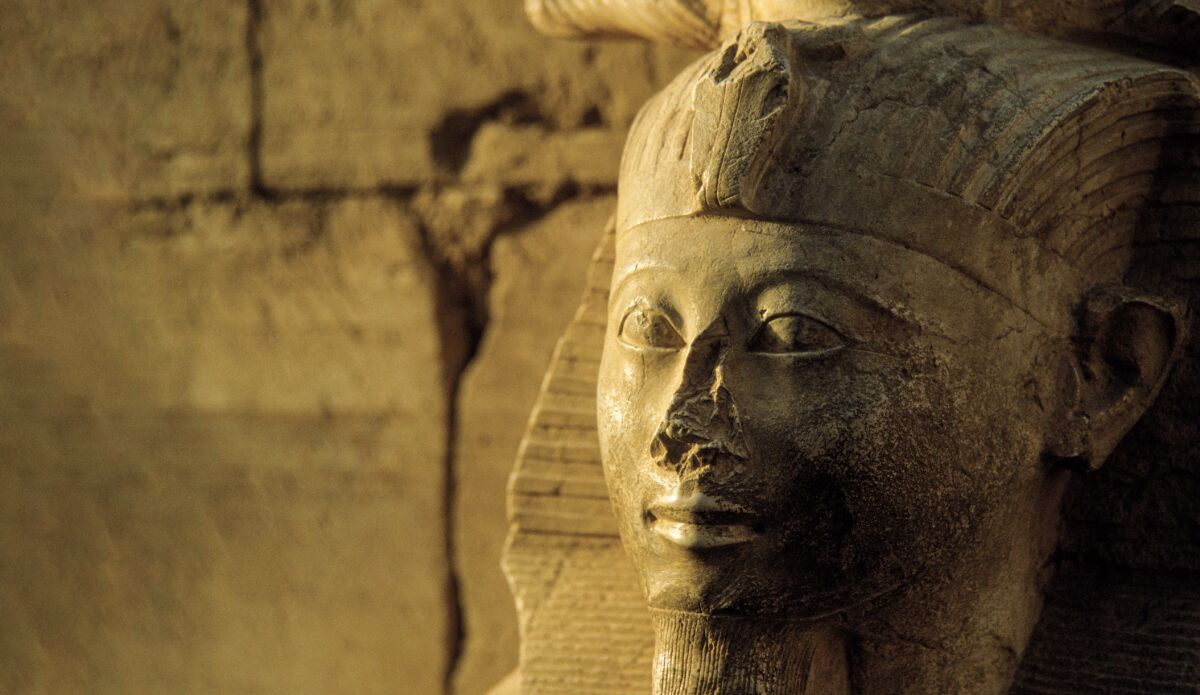
Anyone Else?
In the field of biblical archaeology, reference is sometimes made to synchronisms. This term refers to the convergence of several unique or independent factors supporting an overarching conclusion. A single discovery taken in isolation can remain unconvincing or speculative, but a string of such synchronisms narrows down a logical conclusion.
In studying Egypt’s history together with the biblical text, one can’t help but notice the wealth of synchronisms. Recall Thutmose ii’s androcide, Hatshepsut’s lack of a son and “spirit inclined” toward foreigners, Thutmose iii’s matchless power and long reign. Then there’s Amenhotep ii’s cruelty, his destruction of Hatshepsut’s monuments, his wariness of foreign magicians, his tubercle-riddled body and the missing latter half of his reign. Recall Thutmose iv’s surprise accession, the yhwh-worshiping nomads mentioned by Amenhotep iii, and Akhenaten’s final repudiation of the very name Amenhotep and his total rejection of Egypt’s many gods—all while Canaan is being conquered by “Habiru.” All of these accounts directly parallel information contained within the biblical text—not only in substance but also in chronology!
On the surface, there appear to be plenty of options for identifying the Exodus pharaoh. Digging down into the details, however, it becomes evident that no other Egyptian period, dynasty and pharaoh gets nearly as close to matching the biblical text as the New Kingdom period’s Thutmosid dynasty pharaoh, Amenhotep ii!
And so, amid the multiplicity of theories about the Exodus pharaoh’s identity from scholars, ancient and modern, should it come as any surprise if the very earliest historians to mention his name—Egyptians, no less—got it right? More than 2,000 years ago, Manetho and Chaeremon—both Egyptian priests and historians—insisted that the pharaoh of the Exodus was, as they identified him in their Ptolemaic Greek language, a pharaoh named Amenophis.
Amenhotep (ii), pharaoh of the Exodus.
Read More: Is This Moses?
Sidebar 1: Why the Ambiguity About the Exodus Pharaoh?
Why is the history surrounding the identity of early Egyptian pharaohs, especially the pharaoh of the Exodus, so obscure? One obvious archaeological reason is the Egyptian practice of damnatio memoriae (“condemnation of memory”). This is the act of excising embarrassing acts, individuals and defeats from historical records. Ancient Egyptian leaders are known to be masters at eliminating their own history.
A case in point was revealed in 2003, with the discovery of the 16th-century b.c.e. tomb of Governor Sobeknakht. An inscription in the tomb revealed that Egypt was almost totally wiped out by a Kushite (Ethiopian) invasion. As reported by the Times, the surprising discovery of this previously unknown event reveals that the ancient Egyptians “‘airbrushed’ out of history one of their most humiliating defeats in battle.” Egyptologist Vivian Davies noted: “Had they stayed to occupy Egypt, the Kushites might have eliminated it. That’s how close Egypt came to extinction …. [This discovery] changes the textbooks.”
But it shouldn’t have needed to. Why? Because this traumatic event was clearly documented, at length, by the first-century b.c.e. Jewish historian Josephus in his Antiquities of the Jews (2.10.1-2). Unfortunately, due to the lack of archaeological evidence, the writings of Josephus—much like the biblical text—were simply ignored by scholars until an artifact was uncovered confirming what he wrote.
Just think: If a near “extinction” event like this was so easily “airbrushed” from Egypt’s history, isn’t it possible, even likely, that the events surrounding Israel’s Exodus might have suffered the same fate?
But what about the frustratingly obscure name of the biblical pharaoh? Why are none of the numerous pharaohs of the Torah mentioned by name? In fact, it is not until the 10th century b.c.e. onward, starting with Pharaoh Shishak (Shoshenq i), that pharaohs began to be named in the Bible.
There’s a fascinating historical reason for this, too. This was not unusual during Egypt’s New Kingdom period, the setting in which Moses authored the Torah. Instead of using the pharaoh’s official name, it was typical at this time to refer to him only by title. “By the Ramesside period (1300–1100 b.c.e.), ‘Pharaoh’ is widely used,” wrote Egyptologist Prof. James K. Hoffmeier in Israel in Egypt. “From its inception until the 10th century, the term ‘Pharaoh’ stood alone, without juxtaposed personal name.” This would fit precisely with the biblical account, with the emergence of personal pharaonic names during the 10th century b.c.e.
But there is another potential reason for the biblical ambiguity surrounding this pharaoh. A recurring motif in the Bible is the notion of blotting out the name of the enemy (i.e. 2 Kings 14:26-27; Deuteronomy 29:19; Psalm 83:5). In Exodus 32:32, Moses himself even discusses with God the possibility of his own name being blotted, or erased, “out of Thy book which Thou hast written”!
In the case of the Exodus pharaoh, there are certain passages that conceivably suggest the intentional erasure of his name from the biblical text. Isaiah 26:13-14 say, “O Lord our God, other lords beside Thee have had dominion over us [i.e. Egypt’s pharaoh]; But by Thee only do we make mention of Thy name. … Thou punished and destroyed them, And made all their memory to perish.”
Verses like this certainly help explain the level of confusion and disagreement about the identity of the Exodus pharaoh. Yet they do not state categorically that the pharaoh cannot be known. As such, we have approached our investigation in the spirit of King Solomon, who wrote, “It is the glory of God to conceal a thing; but the glory of kings is to search out a matter” (Proverbs 25:2).
Sidebar 2: Hollywood’s Favorite Pharaoh
Proponents of a Ramesside Exodus pharaoh—most commonly Ramesses ii—use Exodus 1:11 as evidence for this identification. This verse says the Israelites built the cities of “Pithom and Raamses”—the latter usually associated with Ramesses ii and his construction of Pi-Ramesses.
Egyptian history shows that Ramesside pharaohs (including Ramesses ii) only arrived on the scene during the 13th century b.c.e., nearly 200 years later than the date of the Exodus consistently highlighted by other scriptures. In response, Ramesside proponents generally dismiss the 480-year period mentioned in 1 Kings 6:1 as merely “symbolic,” Judges 11:26 as “erroneous,” and the chronologies of 1 Chronicles 6 as “doctored” (see our article here for more detail).
Yet identifying the Exodus pharaoh as Ramesses ii (or any of the other Ramesside pharaohs) based on Exodus 1:11 leads to further issues. Exodus 2:23 states that this earlier pharaoh died before Moses returned to save the Israelites. Even if Exodus 1:11 was a link to Ramesses ii, Exodus 2:23 would disqualify him from being the pharaoh of the Exodus.
But what about this biblical reference to “Raamses”—how to explain it? Fifteenth-century proponents identify it as a later scribal edit known as an “anachronism”—a more familiar, later term used for a more obscure, earlier name (for example, our common anachronistic use of the term “France” when describing ancient “Gaul”). Such a scribal edit could conceivably have been accomplished by the Prophet Samuel (who lived at the end of the Ramesside period)—an individual traditionally ascribed to part of the early compilation of the biblical texts (particularly Joshua, Judges and 1 Samuel), which put an emphasis on place-names as they are “to this day.”
But we need not simply speculate that “Raamses” was being used as an anachronistic term; we already know that the term is used anachronistically in the Bible. That’s because this same geographical name is found in the account of the patriarchs Jacob and Joseph (Genesis 47:11, the “land of Rameses”). Should this patriarchal period also be brought centuries forward and squeezed into the 13th-century Ramesside period? Certainly not.
This conclusion, then—that the “Raamses” of Exodus 1:11 was evidently a later name used to describe an earlier, lesser-known location—actually matches with the testimony of our earliest Egyptian record of the Exodus, that of the third century b.c.e. Manetho. He associates our Israelites repeatedly with the earlier city Avaris (as relayed throughout much of Josephus’s Against Apion, Book 1). Ramesses ii later constructed his capital Pi-Ramesses on the northern end of this territory of Avaris, near the site of the former, original city.
There’s more to this debate about Exodus 1:11: For a more detailed explanation, see our article, “The ‘Raamses’ of Exodus 1:11: Timestamp of Authorship? Or Anachronism?”
Sidebar 3: Dating Specifics: Pharaohs of the 18th Dynasty
Although the dating of Egypt’s New Kingdom period has become much more refined, significant debate still exists. Different chronological frameworks include an earlier “high chronology,” a “middle chronology” and a later “low chronology.” As stated, this article favors high chronology. The following are fairly standard high-chronology dates pertinent to this article (low chronology lowers certain of these dates by two or three decades, and middle chronology is somewhere in-between):
Ahmose i = 1570–1546 b.c.e.
Amenhotep i = 1546–1526 b.c.e.
Thutmose i = 1526–1512 b.c.e.
Thutmose ii = 1512–1504 b.c.e.
Hatshepsut = 1504–1483 b.c.e.
Thutmose iii = 1504–1451 b.c.e.
Amenhotep ii = 1453–1426 b.c.e.
Thutmose iv = 1426–1416 b.c.e.
Amenhotep iii = 1416–1377 b.c.e.
Akhenaten = 1377–1360 b.c.e.
Prof. Douglas Petrovich, for example, agrees with a high-chronology reign of Amenhotep ii beginning 1453 b.c.e., with an Exodus date of 1446 b.c.e. (derived 480 years from a temple-construction date of 967 b.c.e.), thus putting the Exodus within Year 9 of his reign. Petrovich further theorizes that Amenhotep ii’s Year 9 campaign, in which he took over 101,000 captives, was an attempt to replenish his slave base in the months following the Exodus event (see his 2006 article “Amenhotep ii and the Historicity of the Exodus-Pharaoh”). It’s an interesting theory, but after everything the Bible describes surrounding the plagues—the total destruction and humiliation of Egypt, not to mention the destruction of the pharaoh’s elite chariot force—is it reasonable to believe Amenhotep ii, only months later, turned around and engaged in one of the most successful slave-gathering military campaigns in history?
Dr. Hoeh agreed with a 1453 b.c.e. accession date for Amenhotep ii (“Notes Regarding Reigns of Kings,” 1983), yet placed the construction date of the temple in 964 b.c.e., and therefore, the Exodus in 1443 b.c.e.—Amenhotep ii’s 10th year, thus immediately following the last significant mention of his reign (the Year 9 campaign), within his “missing years.”
As stated, we have chosen not to lock ourselves into such rigid chronological systems from the outset. There is the debate between high, middle and low chronology, but within these general frameworks there are significant debates regarding regnal length, coregency and other calculations, resulting in numerous variations of each chronology. Was Thutmose ii’s reign as long as 13 years, or as short as three? The former is usually preferred—but the latter would significantly adjust ensuing chronological schemes. What about Amenhotep iii and his son Akhenaten? Generally, no coregency is preferred—though some scholars posit a co-regency as long as 12 years. Others place the beginning of Akhenaten’s reign as early as 1382 b.c.e. The list goes on.
Generally, where possible, such chronologies are anchored to astronomical data (such as the Sothic Cycle), referencing astronomical observations documented on inscriptions. But these are rare. Moreover, there is debate about where such ancient observations were made, let alone exactly when (both of which radically affects dating, to the tune of years or even decades).
In Studies in the Reign of Amenophis ii, Peter Der Manuelian highlights at length the debate over dating Amenhotep ii using astronomical data—including attempts of Egyptologists to “emend” certain inscriptions, artificially correcting assumed “errors” in order to iron out contradictions in chronology! This discussion “reveals the diversity of opinion among scholars and the multiple factors involved in dealing with these dates,” he concludes. “It is this writer’s opinion that the problem cannot be conclusively solved from the data presently available. Too many solutions hang on emendations ….” As such, he defers to the least-contested anchor date: a lunar-derived date for the Battle of Megiddo. “On the basis of an unamended Battle of Megiddo, we are left with two choices for Tuthmosis iii’s dates [from which his son Amenhotep ii’s dates are extrapolated]—either an accession in 1504 b.c. with death in 1450 b.c. [high chronology], or an accession in 1479 b.c., with death in 1425 b.c. [low chronology].”
Naturally, such a struggle to reconcile astronomical data will prove no surprise for the Bible believer. After all, events such as Joshua 10:13 (“And the sun stood still, and the moon stayed”) and Isaiah 38:8 (“the sun returned ten degrees”) already throw such reliance on astronomical extrapolation into doubt. From a Bible-literal standpoint, existing difficulties in research aside—on the basis of such potential astronomical changes, how reliable can astronomical dating be anyway?
But what about these two foremost chronological variations, highlighted by Manuelian—high versus low? Does the entire early Exodus outline stand or fall based on the accuracy of high chronology over the comparatively popular low?
Not at all. Interestingly, there is a textual variant of 1 Kings 6:1—found in the second century b.c.e. Septuagint (lxx)—which gives 440 years from the Exodus to the start of construction on Solomon’s temple. It is still a matter of debate as to why the lxx gives 440 years, as opposed to the 480 years of the Masoretic Text (mt) as found in most Bibles—whether one or the other was the result of a copyist’s error in transcribing a numeric symbol, or something else entirely. Whatever the case, this alternate 440-year period would put the Exodus near the end of the reign of one and the same Amenhotep ii on the low chronology scheme—generally also aligning the rest of the events with the same respective pharaohs.
It is my contention that this chain of events in ancient Egyptian history—starting with Kamose, the pharaoh who “knew not Joseph,” all the way to Akhenaten, pharaoh on the tail end of the conquest of Canaan—is too perfect to be anything other than a fit for the chain of biblical events. And again, it is my contention that the high chronology is the correct scheme, in conjunction with the mt’s 480-year period. But for those who may take issue with this particular interpretation of Egyptian chronology, they may draw the very same conclusions between low chronology and the lxx’s 440 years. (For more on this subject, read “Amenhotep II as Exodus Pharaoh—With a Low Egyptian Chronology?”)
Sidebar 4: How Did the Exodus Pharaoh Die?
Many believe that the Exodus pharaoh died in the Red Sea. Psalm 106:11 says of the Egyptian army that there was “not one” left alive there. But many Amenhotep ii proponents—primarily those who date the Exodus event earlier in his reign—believe Amenhotep ii survived his army’s defeat at the Red Sea. Does Amenhotep ii’s survival negate the biblical account?
In his article “Pharaohs of the Time of the Exodus,” Keith Stump—likewise positing an Exodus during Amenhotep ii’s 10th year—briefly explained: “Contrary to the common notion about the Pharaoh of the Exodus, Amenhotep ii did not drown in the Red Sea with his army. Read carefully Exodus 14:23-31. Ancient records reveal that Amenhotep ii’s reign lasted no less than into his 26th year. … Sixteen of those 26 years followed the Exodus.” Prof. Douglas Petrovich—in a 2021 Digging for Truth podcast interview titled “Amenhotep ii as Pharaoh of the Exodus”—addressed and explained other commonly cited proof texts for the Pharaoh’s death in the Red Sea, such as Psalm 106:11 and Psalm 136:15 (the Hebrew word for “overthrew” David elsewhere applies to himself, during his life—Psalm 109:23).
In my opinion, given all of the above data, the Exodus event is better placed within the latter part of Amenhotep ii’s reign—whether that infers a slightly later construction date of Solomon’s temple, a slightly earlier chronology for certain 18th Dynasty pharaohs, or some other explanation. Certainly, aligning the Exodus with the end of Amenhotep ii’s reign would at face value seem to be the best inference from the biblical account (though not absolutely necessary, as above), but also based on Amenhotep ii’s Year 23 stele, his comparatively young death, and in particular, the surprise succession of his younger son, Thutmose iv. Such a chronological adjustment would also place an Israelite entrance into Canaan closer to the end of Amenhotep iii’s reign (and the start of Akhenaten’s), and put Moses’s fleeing into Midian firmly after the death of Hatshepsut, during the period of sole rule by Thutmose iii. Naturally, a sufficient discussion of this topic requires a separate article.
Interestingly, regarding Amenhotep ii’s eldest son that predeceased him (a prince of the same name, Amenhotep), Manuelian writes: “According to [Egyptologist Donald] Redford, this prince Amenhotep was born during the first five years of Amenophis ii’s reign, since he held office by the king’s 20th year, and therefore would have been older (and thus closer in line to the throne) than the future Tuthmosis iv.”
There is some level debate about the identity of this Prince Amenhotep—if he was indeed Amenhotep ii’s son and intended successor. But if so, this son’s death sometime beyond Year 20 of his father’s rule would surely seal the debate, in placing the “death of the firstborn” and the Exodus at or near the very end of Amenhotep ii’s reign. (For one particular chronological reassessment of the reigns of the 18th Dynasty pharaohs, including a possible alignment of the Exodus with the final year of Amenhotep ii’s reign, see the following article.)
What about Amenhotep ii’s body? The pharaoh’s mummy (CG 61069) has been identified. His body, again, was scarred by an unusual, potentially widespread disease. In their 2016 reanalysis of the 18th Dynasty mummies, M. E. Habicht, A. S. Bouwman and F. J. Rühli expressed certain “reservations” about its identity—though they concluded that it “should be considered as Amenhotep ii until proven otherwise” (“Identifications of Ancient Egyptian Royal Mummies From the 18th Dynasty Reconsidered,” American Journal of Physical Anthropology).
Thus, we have two interesting scenarios: The first suggests that this is Amenhotep ii, with a body bearing the scars of plague or disease. The second suggests that this is someone else entirely from the time period, with the pharaoh’s body remaining at large (perhaps lost in the Red Sea?). Based on the collective evidence, the former seems the most probable: that this is Amenhotep ii. Yet the possibility also remains open that Amenhotep ii’s body could have been recovered from Egypt’s defeat at the Red Sea and subsequently embalmed in accordance with Egyptian tradition. (Exodus 14:30, after all, states that Egyptian bodies washed ashore.)
It is interesting to speculate. But either way, the outcome has no bearing on the accuracy of the biblical text.
Article updated 3/8/25.
